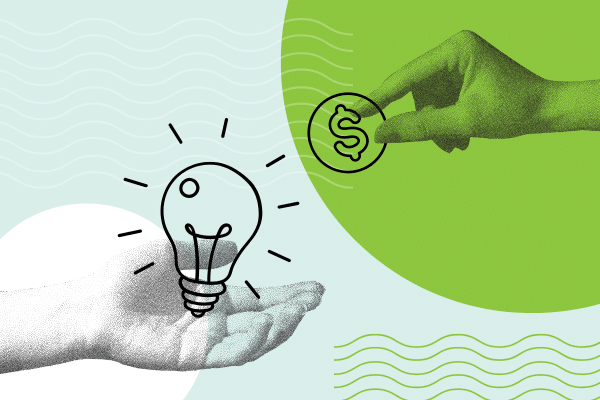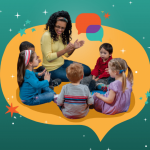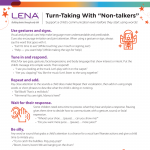You believe (or already know) LENA Grow transforms early childhood programs. Maybe you’ve seen the research showing how conversational turns build brains. Or perhaps a program director or coach told you about teachers who felt more confident and children who thrived. But when it comes to securing early childhood funding to bring LENA Grow to your community, the path forward isn’t always clear.
Where do you start looking for funding?
How do you write early childhood grant proposals that capture a funder’s attention when they’re reading dozens of similar requests?
What makes your story compelling enough to stand out?
LENA’s Chief Impact Officer, Katharine Correll, recently hosted a webinar called “Funding Your LENA Grow Program” that answered these exact questions. She shared practical strategies that work, whether you’re writing your first grant proposal or your 50th.
These strategies work for any program, not just LENA Grow. And you likely already have most of what you need to succeed.
Start at the End: Why Grant Funders Care About Outcomes
Many grant proposals start with the program they’re trying to get funding for and then explain what the program does. That approach misses what funders actually want to know.
Many funders care more about the change you’ll create than the specific program you’ll use to create it.
Katharine walked us through a simple exercise that flips this thinking. Picture filling in blanks like a Mad Lib: “We want [outcome like “increasing kindergarten readiness”]. We’ll do this by [activity like “improving teacher-child interactions”]. We need LENA Grow because [context like “it provides the researched backed tools, data, and guidance needed to accomplish this.”].”
This follows what’s called a theory of change — a roadmap showing how investment leads to impact.
When you frame early childhood education grants this way, funders see themselves partnering with you to achieve something meaningful. Once those outcomes are crystal clear, finding the right early childhood funding partners is more straightforward.
People Give to People: Building Grant Funder Relationships That Last
Securing funding takes more than a perfect proposal. It takes building relationships with people who share your vision.
Katharine emphasized four principles that transform how you communicate with funders:
- Data makes you memorable. Among all the requests funders receive, objective information sets you apart. LENA’s conversational turns data gives you something concrete to share that other programs simply don’t have.
- Passion is contagious. Don’t hold back your excitement about what’s working. When a teacher has a breakthrough moment or a child who was quiet suddenly engages in conversation, tell that story. Your passion can ignite a funder’s passion!
- There’s no such thing as too much contact. Send updates. Share challenges. Forward relevant articles. You’re building trust. Program officers expect regular communication and appreciate staying connected.
- Balance the big picture with individual stories. Funders need both. Share how your program reaches 200 children across five centers AND tell them about the teacher who almost quit but stayed because LENA Grow renewed her confidence. One shows scale. The other shows heart.
There are no rejections, only timing. A “no” today means “not yet.” Keep the relationship warm through Google Alerts for local funders, searches on Candid.org, or even asking AI tools to identify foundations interested in professional development grants for early childhood programs.
What happens when a funder finally says yes and asks for a full proposal? That’s where LENA’s built-in data is incredibly helpful!
Your Built-In Grant Metrics: The Power of LENA Data
For grant proposals, you need to prove that your request is worth it because of the evidence backing it up. Or for a grant renewal, you need to prove that what a funder has already invested in is still worth continuing to invest in.
You need to prove that what you do works. But gathering meaningful data may feel like adding another full-time job to your already packed schedule.

LENA solves this problem before you even write your first proposal.
Every LENA partner receives a Partner Impact Report with grant-ready metrics already calculated. No extra surveys. No complicated spreadsheets. The data you need sits right there in your dashboard.
And if you’re not a LENA partner yet, we still provide numerous resources that clearly explain the data that supports LENA Grow’s impact on various early childhood education domains.
The reporting advantage matters throughout the life of the grant. When a funder asks for your six-month update, you pull your Partner Impact Report and share current numbers. Done. When they want your final report, same process. The technology handles measurement while you focus on supporting teachers and children.
Pair LENA’s data with metrics you already track — teacher retention rates and classroom quality scores. Then your story is even stronger. You’re demonstrating how LENA Grow fits into your broader mission to transform outcomes for children in your community.
You’re Not Alone in Securing Early Childhood Funding for Your Program
Funding challenges don’t disappear overnight. But they become manageable when you have a clear framework and the right support.
Start with outcomes that inspire funders to partner with you. Build relationships through consistent, authentic communication. Let LENA’s built-in data do the heavy lifting for your proposals and reports.
LENA provides more than technology and professional development. We’re here to help set you up for grant success. So you can implement LENA Grow effectively. You’re not figuring this out alone.
Programs across the country have successfully secured early childhood education grants using these exact strategies. The path forward exists. You just need to take the first step.
Ready to dive deeper? Watch the full webinar replay to hear Katharine walk through finding funders, crafting compelling proposals, and using LENA’s resources to strengthen your grant applications. Stream the replay here!
Want a roadmap you can follow? Download LENA’s free “Quick Start Guide to Philanthropic Funding” for step-by-step guidance, checklists, and templates that make the grant process less overwhelming.



